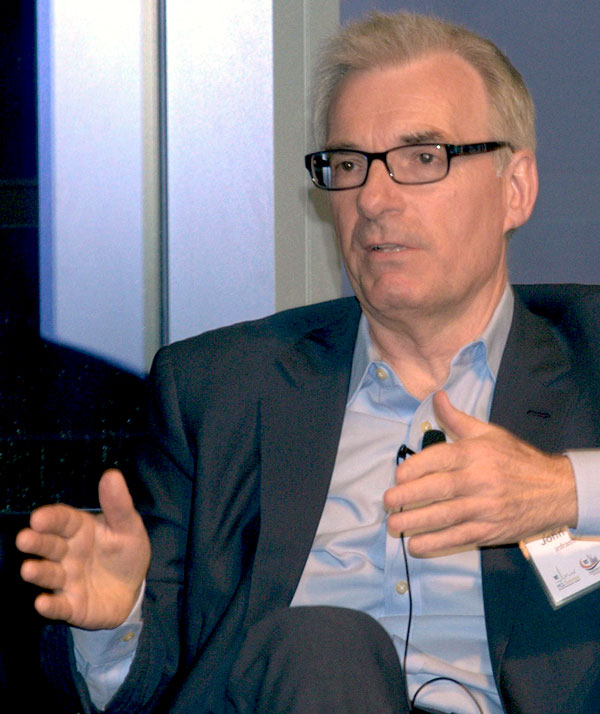The new Ontario government is hitting the pause button on spending and that suggests not all 29 Infrastructure Ontario (IO) projects now in the pipe will get the green light, a seminar of Young Construction Leaders (YCL) was told in Toronto.
John McKendrick, executive vice-president of IO, was part of the Toronto Construction Association panel at the Globe and Mail Centre, discussing the present and future of construction.
The event kicked off with a quick horizon check on the industry with panellists Geoff Smith, president and CEO of EllisDon, and Jennifer Coco, CEO of the Coco Group, a family-owned and operating asphalt roadbuilding and paving company.
The consensus was the industry is at the top end of a busy cycle and will slow down in the year ahead.

“Under the previous government we were pushed to throw out as much work as possible and probably contributed to the overheating of the market, which was a problem,” McKendrick said. “We need to get back to a steady pipeline. Big projects take two years of planning, so this is a good time to go back and ask what changes we can make to make the process better.”
Moreover, he said, IO recognizes what the industry and organizations like the Residential Construction Council of Ontario have been saying about the need to streamline the approvals process.
He said IO wants to be less prescriptive and standardize proposal requests as well as change the way things are specified to allow contractors more scope to innovate and reduce costs.
“We’re trying to move to electronic bidding, as opposed to all the physical stuff,” he said.

Coco said the time and resources required for approvals in Ontario add cost and it’s the government that ends up paying for it.
“Some 80 per cent of our work is for governments,” she said, noting contractors are getting conflicting stories. “For example, if a bald eagle is not an endangered species in the United States anymore why is it still endangered in Canada?
“We find it very challenging in terms of the number of people we have to work with because the legislation is not standardized. One inspector in one region says one thing and another says something different.
“To get environmental approvals in Ontario we have to walk in with all kinds of binders with all the consultants signing off. I have to get 100 permits in Ontario but in Manitoba and Saskatchewan it’s four. The red tape delays the process and is not helping the customer.”
McKendrick said he’s sympathetic to the issue because it’s unpredictable and that’s something the construction industry does not like.
“You have a small group of individuals who decide what is at risk and they won’t give you an answer until you start and then they change their minds,” he said. “We need to change this. The industry needs warning time and you can’t just throw something at them in the middle of a project.”
Smith, who took over EllisDon from his father Don, the company founder, now runs an employee-owned $3.5-billion-a-year operation with 15 national and international offices. He said those in the industry should be careful to consolidate their positions and not make rash decisions for a few thousand a year more.
More competition is coming in from global conglomerate firms and many have acquired local contracting companies.
“We don’t want to get eaten for lunch, we want to eat lunch,” he said.
While he said he was “plenty scared” of the big international contractors he thinks Canada can compete.
“If you want to get into the middle of a shootout between EllisDon and PCL, you better have your act together. One of the worst projects we have worked on was a multi-national which couldn’t deliver. They came to Canada, they didn’t understand the market. They should have done the research before they came.”
Companies also need to evolve, he said, staying ahead of their clients and the competition by leveraging information technology (IT).
“I had a conversation with a client who told me to ‘stay in the box,’ ” Smith said. “But you have to be out front and sometimes that means you’re standing alone. It’s not always comfortable because it involves risk. But you’ll figure it out.”
Also, he said, the change towards more integration of IT in construction has to be driven from the top down.
While the construction industry is generally slow to adopt new technologies, it will have to learn to adopt them because it is inevitable, the panel agreed.
The trend towards electronic bidding and cost analysis means it’s time to get on board the data train.
“We’re paving the Gardiner and instead of surveyors we have drones,” said Coco. “That’s just the way it is now.”
Also, she said, data points are a more efficient way to manage because it can track productivity and results throughout the enterprise.
With the baby boomer retirement wave, contractors may be ever more reliant on technology. The shortage of truck drivers, Coco said, may prompt the adoption of self-driving vehicles too quickly with dire consequences.
“We need more labourers,” she said. “I was talking to Labourers’ International Union of North America president Joe Mancinelli about this. He said Local 183 has 55,000 members and they still need more.”
The issues facing the construction industry in the future may be more focused on attracting employees to the trades and construction management along with diversity and gender balance, the panel suggested.
EllisDon is reviewing its hiring and promotion policies, Smith said, because while an internal survey found employees weren’t overly concerned with gender and ethnic balance in a practical sense, there was a perception that white males tended to get promoted more quickly and paid more.
It’s the perception that is the issue, he said.
“I wish there were more women in our sector,” added Coco. “When I graduated from my MBA program there were three women. That same class is now 50-50. The education stream has changed but its not quite there yet in the workplace.”











Recent Comments
comments for this post are closed